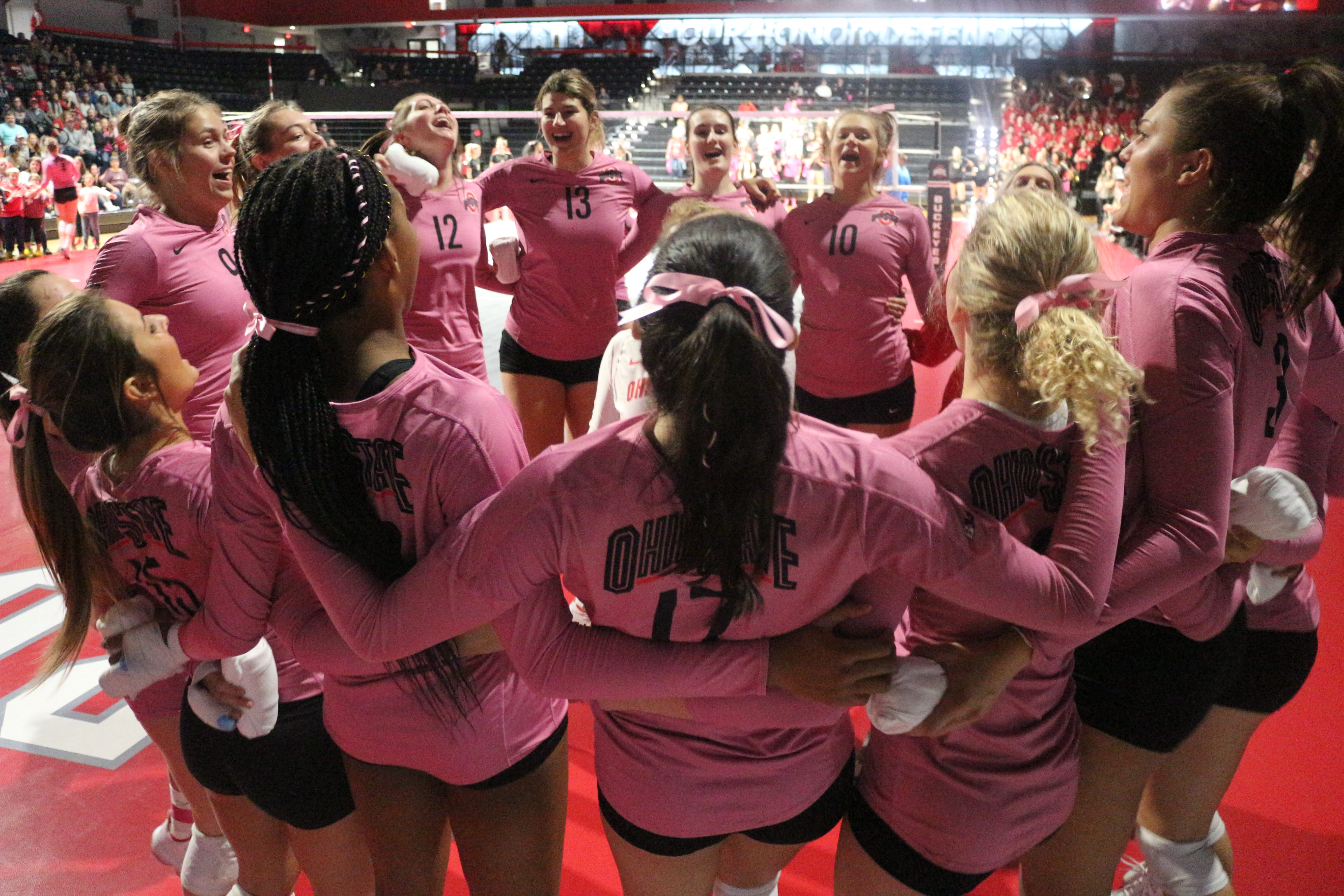
Ohio State Women’s Volleyball team getting pumped up before the home game against Purdue on Oct. 19. Ohio State lost 2-3. Credit: Reggie Thomas | For The Lantern
The fall was set to be a new beginning for Ohio State women’s volleyball — until it wasn’t.
Head coach Jen Flynn Oldenburg was hired in January to lead a team that had finished the 2019 season with a 15-17 record. A shortened spring practice schedule and canceled fall season due to COVID-19 concerns forced the team to alter both its routine and mindset.
For senior defensive specialist Hannah Gruensfelder, the postponement decision was met with a sadness that turned into drive to improve.
“Lots of tears, lots of anger and frustration,” Gruensfelder said. “But also just a lot of –– to move on and get better.”
The Big Ten announced the postponement of its fall sports seasons Aug. 11 — four days after the women’s volleyball team had begun practicing for the fall season.
Despite the Big Ten erring on the side of caution, Oldenburg and Gruensfelder expressed confidence in the safety protocols Ohio State had put in place.
“I think we were leading the charge for the Big Ten and, honestly, the rest of the nation, and I think that we could have succeeded in having a season and been safe, but obviously that wasn’t the outcome,” Gruensfelder said. “But I definitely felt comfortable.”
While she held confidence in the university’s handling of COVID-19, Oldenburg said that there were many unknowns and the health and safety of the players had to remain a priority.
Although the decision brought about a lot of emotions, the first-year head coach felt that the timing of it was better than a postponement decision being made at a later date.
“Is it better to get into it and have a couple of matches under your belt and then they tell you to stop, or is it better just a few practices? I would like to think it was better just a few practices, because now we just continue to practice and continue to train and get better,” Oldenburg said.
Gruensfelder said the team is continuing to participate in the 20-hour practice weeks that were in place for preseason work.
The postponement will prevent the Buckeyes from accumulating wins in the fall, but Oldenburg said that the extra time between seasons will make up for the time lost in the spring.
With virtual meetings and individual workouts becoming the norm in the months following the beginning of the pandemic, the fall will provide the team with a chance to improve on the court.
“Having that time right now is just going to help us even more,” Oldenburg said. “We have time to get stronger and not rush back into competition. We have time to have our freshman get acclimated to what it’s like to be a student on a college campus.”
Although there may be benefits to be had in terms of team improvement, the delayed start to the season has impacted student-athletes’ academic plans.
Oldenburg said that fifth-year senior middle blocker Jordan Fry was set to graduate in the winter but is speaking to an academic advisor to see what options she has for playing in the spring.
Gruensfelder said the unexpected shift of the season affected class selections for student-athletes who wanted to save harder classes for the usually open spring season and take a lighter class load during the fall.
Along with the players, Oldenburg and her coaching staff have been forced to adapt. In terms of the new staff’s recruiting efforts, the pandemic has forced the group to use virtual options to interact with desired student-athletes.
Despite having to be creative with how she interacts with the recruits, Oldenburg stressed that the essence of recruiting remains unchanged.
“It’s really about building relationships, which at the end of the day would still be important regardless if they’re on campus or not,” Oldenburg said. “So it’s just really about getting to know them and sharing our culture and our program with them and their family and really finding the right people.”
Oldenburg said that she is confident in her staff’s ability to adapt and teach during this unusual time.
In terms of preparing for a potential spring season, Oldenburg is not concerned about the unusual timing of the games.
“I’ve been saying probably since March when we weren’t even sure about our Big Ten schedule back then, it was like, ‘Just tell me who to play and when to play it and we’re going to show up,’” Oldenburg said.
Whenever the Buckeyes are able to compete on the court again, the match will mark not only the beginning of a season but a new era for the program.
Given Ohio State’s resources and local talent in the area, Oldenburg set high goals for what she wants to accomplish as head coach of the program. With a short term goal of making it back to the NCAA tournament for the first time since 2016 and a long term goal of competing for Big Ten titles, Oldenburg is setting the bar high for a program that is awaiting a chance to play.
“My vision’s pretty big, pretty bold, but being an alum, it’s a big deal to me,” Oldenburg said. “We want to be great and so we’re going to push for that every year.”


